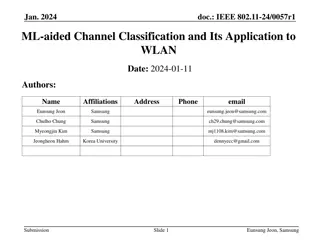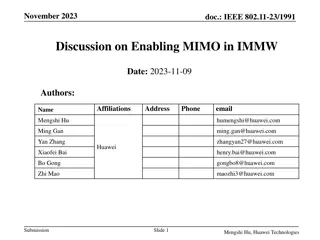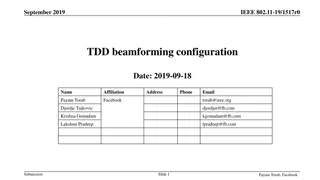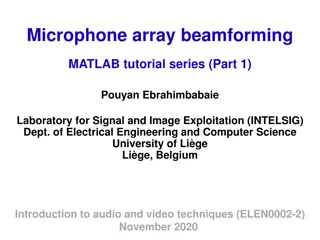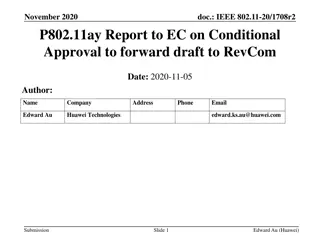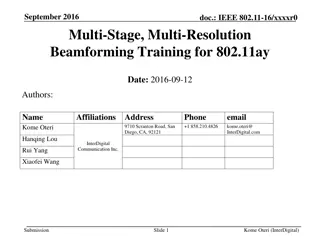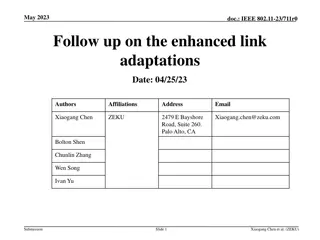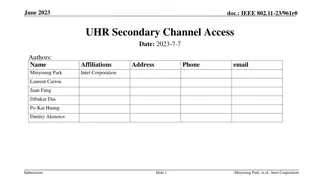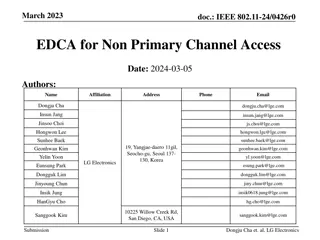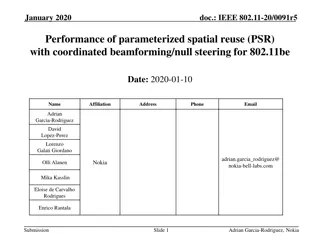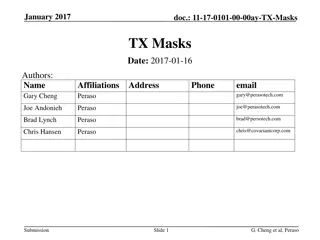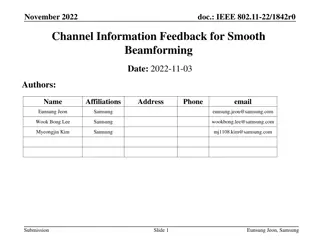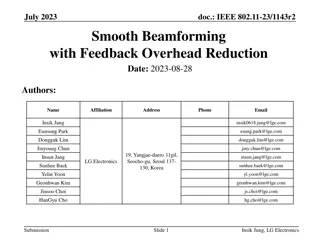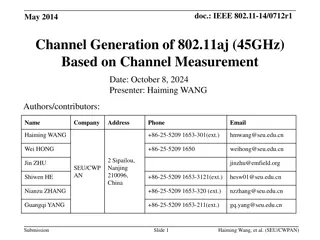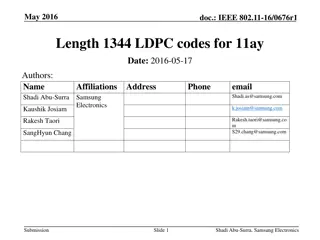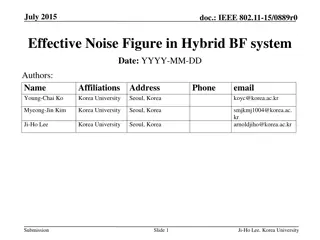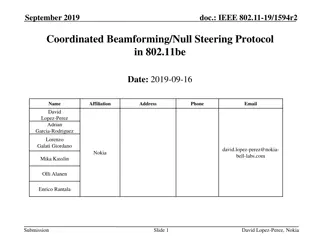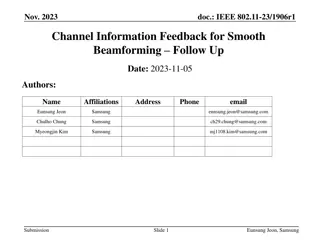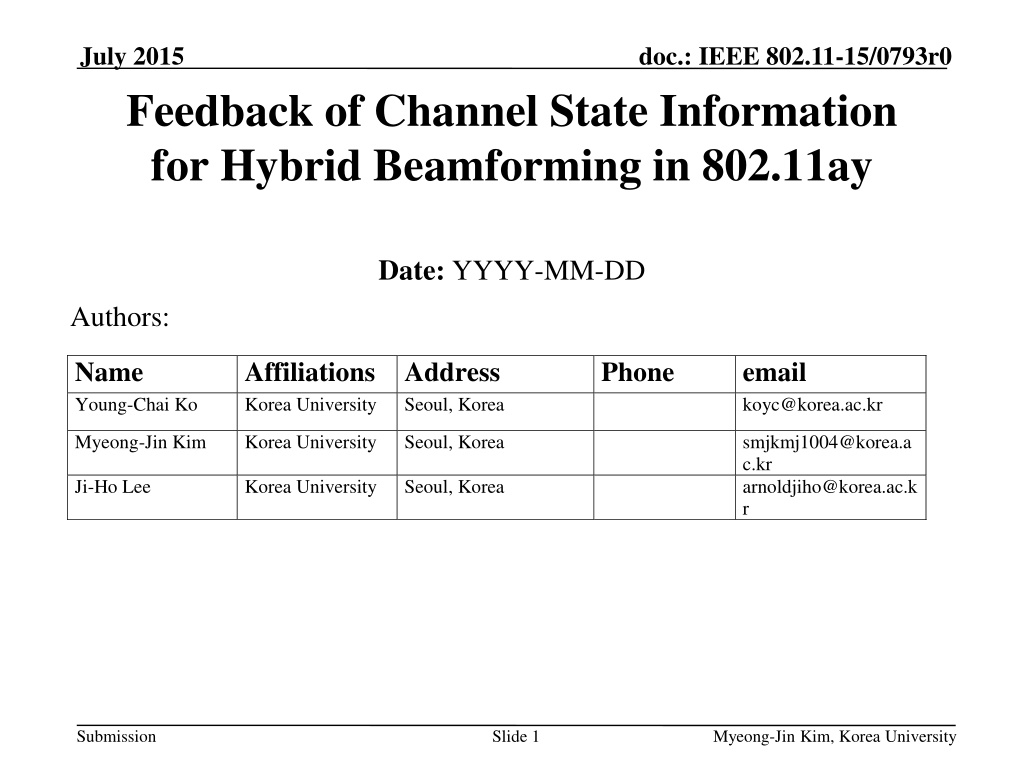
Feedback of Channel State Information for Hybrid Beamforming in 802.11ay
This document discusses the feedback of channel state information (CSI) for enabling hybrid beamforming in the context of IEEE 802.11ay. It covers the challenges in estimating the effective channel matrix, the roles of RF and digital beamformings, and contributions towards obtaining CSI in hybrid beamforming systems.
Download Presentation

Please find below an Image/Link to download the presentation.
The content on the website is provided AS IS for your information and personal use only. It may not be sold, licensed, or shared on other websites without obtaining consent from the author. Download presentation by click this link. If you encounter any issues during the download, it is possible that the publisher has removed the file from their server.
E N D
Presentation Transcript
July 2015 doc.: IEEE 802.11-15/0793r0 Feedback of Channel State Information for Hybrid Beamforming in 802.11ay Date: YYYY-MM-DD Authors: Name Young-Chai Ko Affiliations Address Korea University Phone email koyc@korea.ac.kr Seoul, Korea Myeong-Jin Kim Korea University Seoul, Korea smjkmj1004@korea.a c.kr arnoldjiho@korea.ac.k r Ji-Ho Lee Korea University Seoul, Korea Submission Slide 1 Myeong-Jin Kim, Korea University
July 2015 doc.: IEEE 802.11-15/0793r0 Abstract Since MIMO is considered for 802.11ay to improve data rates and the link reliability, hybrid beamforming is recommended for practical implementation in 802.11ay [1][2]. This contribution discusses on the feedback of channel state information (CSI) to enable hybrid beamforming in 802.11ay. Submission Slide 2 Myeong-Jin Kim, Korea University
July 2015 doc.: IEEE 802.11-15/0793r0 Hybrid Beamforming System model NRx antennas NRx,RF RFchains NTx antennas NTx,RF RFchains DAC DAC ADC ADC WRx,BB FTx,BB = s 1 H s y s s Digital Beamforming Digital filter DAC DAC ADC ADC Heff = WRx,RFHFTx,RF Received signal: y = WRx,BBWRx,RFHFTx,RFFTx,BBs + n = WRx,BBHeffFTx,BBs+ n where Heff = WRx,RFHFTx,RF is the effective channel. Optimal RF and digital weights, WRx,BB, WRx,RF, FTx,RF, FTx,BB at AP (Tx) and STA (Rx) are required to be found in terms of SNR. Generally, the number of RF chains is less than the number of antennas (NTx,RF<NTx and NRx,RF<NRx). Submission Slide 3 Myeong-Jin Kim, Korea University
July 2015 doc.: IEEE 802.11-15/0793r0 Roles of RF and Digital Beamformings Increase the link gain RF beamforming Increase the spatial multiplexing gain Digital beamforming AP (or Tx) needs to know the effective channel matrix (or simply CSI) to obtain beamforming gain. Submission Slide 4 Myeong-Jin Kim, Korea University
July 2015 doc.: IEEE 802.11-15/0793r0 Difficulty in Estimating Channel Matrix Effective channel matrix Heff = WRx,RFHFTx,RF We need to know the full CSI, that is, H for the calculation of Heff. However, it is difficult to estimate full CSI in mmWave systems due to the following reasons. Usually we have small SNR value before beamforming. The large number of antennas causes to require a huge training overhead. Even though the full CSI is obtained, developing the efficient feedback scheme of the full CSI is difficult due to the large size of the channel matrix. So, we estimate the effective channel matrix instead of the full channel matrix once RF beams are determined. Submission Slide 5 Myeong-Jin Kim, Korea University
July 2015 doc.: IEEE 802.11-15/0793r0 Contributions We here want to provide an example of procedure about how to obtain CSI at TX in hybrid beamforming system. Submission Slide 6 Myeong-Jin Kim, Korea University
July 2015 doc.: IEEE 802.11-15/0793r0 Procedure for Hybrid Beamforming Design with Effective Channel Information (1/2) AP STA Heff = WRx,RFHFTx,RF 1 2 3 Determination of RF beamforming/filter Design of digital beamforming/filter Feedback of effective channel information Submission Slide 7 Myeong-Jin Kim, Korea University
July 2015 doc.: IEEE 802.11-15/0793r0 Procedure for Hybrid Beamforming Design with Effective Channel Information (2/2) Stage 1: Determination of RF beamforming/filter Without considering the effect of digital beamforming/filter (WBB =I , FBB = I), RF beamforming/filter are selected based on the beam training algorithms such as SLS, BRP defined in 802.11ad. Stage 2: Feedback of effective channel information AP sends the pilot sequence. STA estimates the effective channel (Heff) and feeds back the effective channel information to AP. Stage 3: Design of digital beamforming/filter AP designs its digital beamforming based on the effective channel information. STA obtains its digital beamforming based on the estimated effective channel. Submission Slide 8 Myeong-Jin Kim, Korea University
July 2015 doc.: IEEE 802.11-15/0793r0 Conclusion We discussed on the need to feed back the effective channel information in 802.11ay. We suggested the procedure to design the hybrid beamforming with the effective channel. Further study on the difference between feedbacks of effective channel information and digital beamforming may be required for 802.11ay. Submission Slide 9 Myeong-Jin Kim, Korea University
July 2015 doc.: IEEE 802.11-15/0793r0 References [1] IEEE 802.11-14/0606r0, Next Generation 802.11ad: 30+ Gbps WLAN [2] IEEE 802.11-14/0431r0, Shared MIMO Architecture for 802.11ay Submission Slide 10 Myeong-Jin Kim, Korea University


